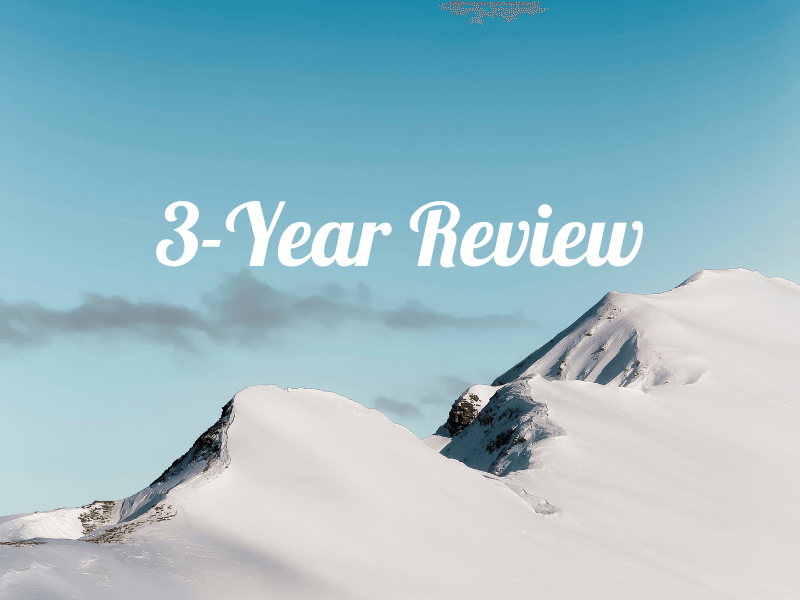
Welcome to my 3-year progress report - in this special income report, I'll share the details of my journey, including the results, strategy, personal experience, and end off with my next steps for 2021.
Let's get started!
Let's start off with the most obvious metric: Total Revenue.
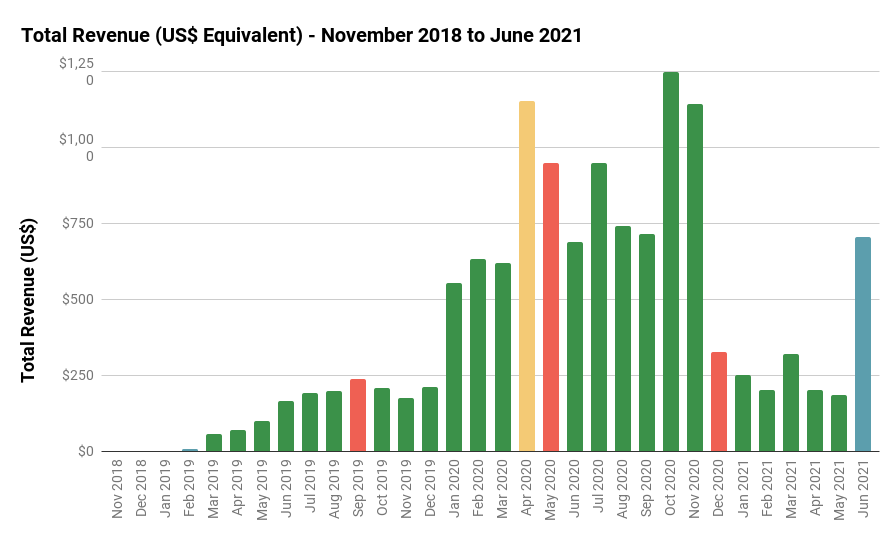
Here, I've plotted monthly revenue since launching TheDermDetective.com in November 2018.
Revenue growth was driven by:
Overall, 2020 was my best year, however, there were 2 significant events that negatively impacted my business (highlighted in red):
More recently, 2021 has been lackluster following the traffic / ranking declines caused by the December 2020 Core Update.
However, I've started to rebuild the website's foundational elements in April and I'm now seeing early results from that work (as shown by June 2021 performance).
In total, TheDermDetective.com generated $13,222, of which $8,115 (61%) came from Amazon Associates, $5,044 (38%) came from third-party merchants, and $63 came from Media.net display ads (<1%).
Next, let's take a look at traffic. I used to measure traffic as Unique Pageviews but later switched to Sessions instead (better aligned with my conversion goals).
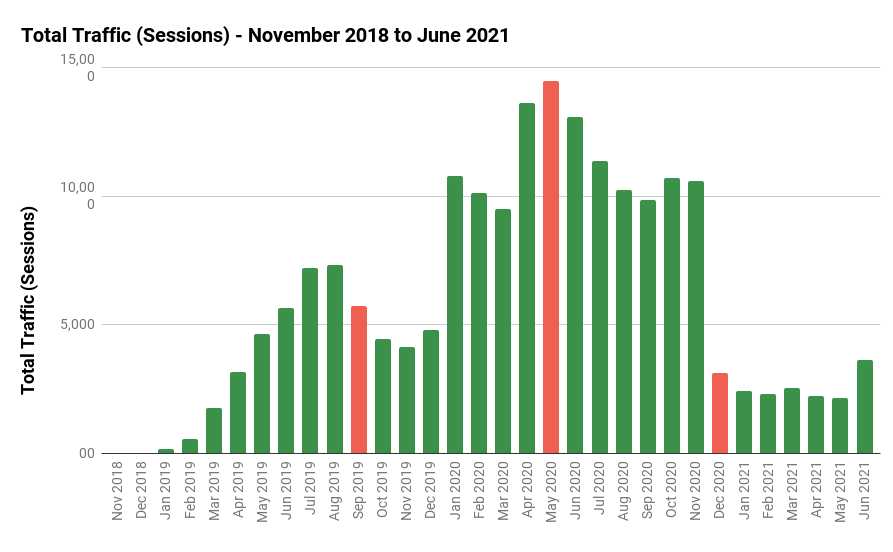
Overall, the trend is very similar to revenue. Here were the key events:
The most important lesson that I learned vis-à-vis traffic is quality, not quantity. It was relatively easy to grow traffic when I targeted low-comp, low-volume keywords in bulk (these were typical "vs" and a few "review" keywords), however, visitors did not convert well on these pages, partly due to my underoptimized content design and partly due to the lower transactional intent compared to "best" keywords.
For example, I observed the following conversion rates by keyword type:
In total, TheDermDetective.com generated 192,326 sessions (206,523 unique pageviews).
Now, let's discuss profitability, as measured by Revenue per Thousand Sessions.
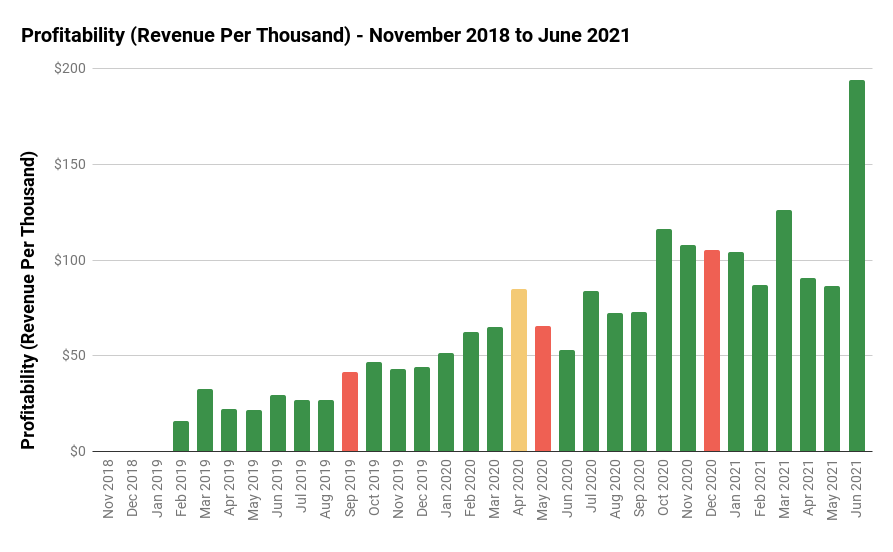
During the first phase (pre-Amazon rate cut), RPM reached around $50 and peaked at $85 in April 2020, the same month as the commission rate cut.
Profitability improved due to rising Amazon earnings per click (EPC), thanks to better content design that resulted in higher conversion rates (more checkouts).
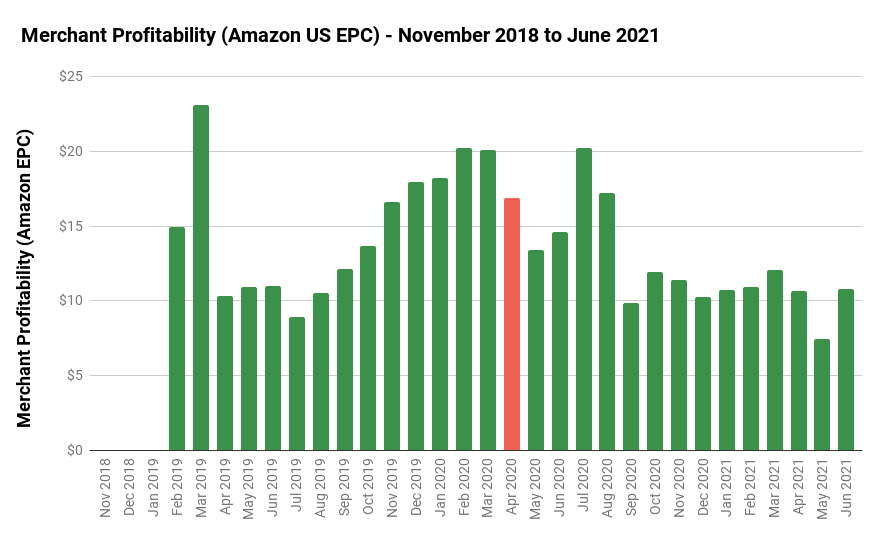
Here's a breakdown of Amazon EPC by its constituent parts:

After April 2020, I began to experiment with alternative merchants and established new affiliate partnerships with brands via affiliate networks and private programs.
This would eventually result in RPMs of $100+ and more recently, almost $200!
During this period, I tried using Geniuslink choice pages to provide users more options but this actually led to 50%+ drop-off rates as less interested users left instead of visiting the merchant.
This "pruning" effect resulted in an artificially high Amazon EPC of $20 in June 2020 as conversion rates skyrocketed while commission rates plummeted.
After fixing this problem, Amazon EPC returned to ~$10, where it has remained.
Overall, profitability has increased over time and this has been the main offsetting force to lower traffic (and sometimes lower commission rates).
With a higher RPM today ($100-$200) than before ($25-$80), I can grow revenue much faster using the same level of traffic. Again, it's all about quality, not quantity.
Improving my conversion rates and identifying profitable affiliate partners remain my top priorities for increasing profitability even further.
Finally, let's discuss the expense profile.
What initially attracted me about this business was its low capital intensity - i.e. you don't need to spend a lot of money upfront or to maintain the business.
And for the most part, that's been true. The majority of my expenses were discretionary - either for software (preferably lifetime licences via AppSumo) or guest posts.
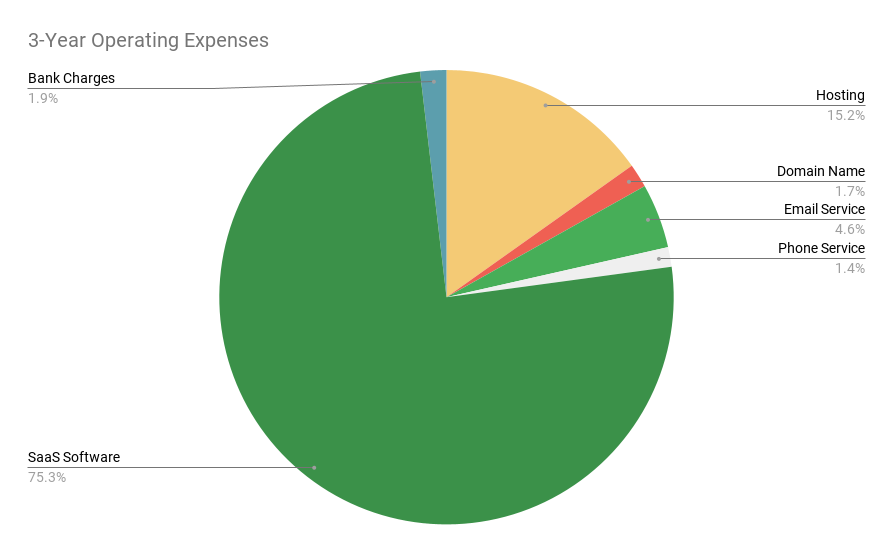
The primary operating (non-discretionary) costs were:
In total, the operating costs were $3,715 (30% of total expenses).
Next, the primary capital (discretionary) costs were:
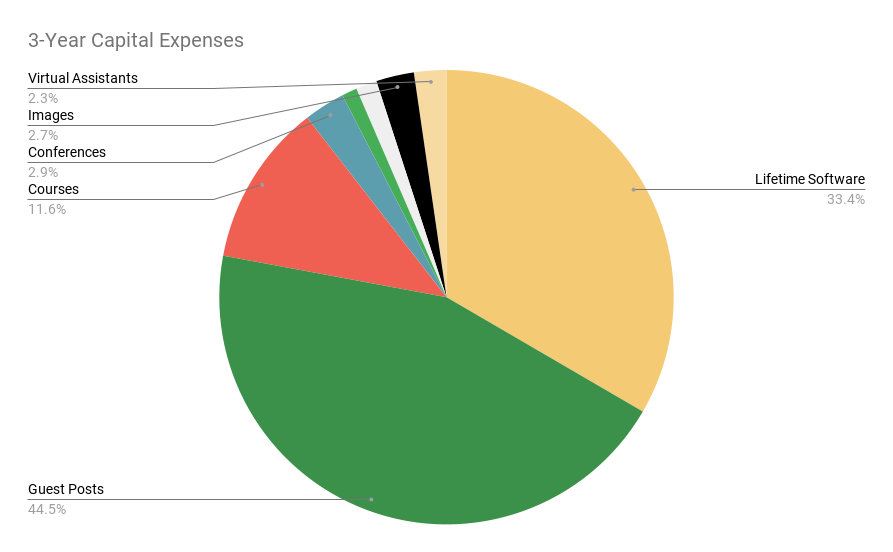
In total, the capital costs were $8,695 (70% of total expenses).
Going forward, I expect to incur fewer capital expenses as I've sufficiently built up my tech stack of lifetime software. The major expenses will be link building (guest posts) and outsourcing (VAs, writers, etc.)
In total, my 3-year expenses were $12,409 (30% operating, 70% capital).
In the last 3 years, TheDermDetective.com generated:
Overall, after an initial capital spend of ~$2,000 ($599 on TASS, $990 on Ahrefs, plus miscellaneous plugins), I've been able to more-or-less reinvest cash flow back into the business which has minimized further capital requirements.
Going forward, I'll need to be more conscious of accumulated P&L to ensure that I'm actually making a profit on this venture. While it's true that you can still build value without a net profit by growing revenue (and hence, your exit price), I have no immediate plans to sell this website, but use it to harvest cash flow instead.
Now, I'd like to discuss the 3 main pillars of an affiliate website and how my strategy has evolved in each one:
Content boils down to 2 elements:
When combined in a harmonious way, a piece of content should engage your reader and deliver meaningful conversions (link clicks, email sign-up's, sales, etc.).
Overall, my content journey has been a steady upward progression as I gained more experience with my subject matter and writing marketing/sales copy.
I learned to optimize content using on-page SEO best practices by placing the right words in the right places, measuring my progress towards ranking / traffic, and using third-party tools like POP, Surfer, MarketMuse, and Frase to deliver objective scores and recommendations to improve content relevancy.
I also learned to increase conversion rates using CRO best practices by designing (and redesigning) my post layout, site templates, call-to-action buttons, and more, as well as collecting insightful data on user behavior via Google Analytics and session recordings & click heatmaps via tools like Hotjar and Analyzz.
Going forward, I need to refine my content strategy and create an actionable plan to scale my process using external writers. This is something that I've procrastinated on, partly due to unforeseen events (Dec 2020 Core Update) and partly due to my own stubbornness and inexperience with outsourcing effectively.
Overall, though, my content journey has been very positive and is definitely one of my core strengths.
In contrast, my backlink journey has been very difficult and I've changed my approach several times along the way.
In short, I started out with whitehat link building, writing high-quality skyscraper articles and running various email outreach campaigns.
I learned to scrape, gather, filter, verify, and email prospects in bulk, and create simple systems to organize, reply, and record campaign results.
Due to the time-intensive nature and lack of meaningful results, I eventually shifted to paid guest posts via agencies like SEOButler and Authority Builders post-CMSEO19.
During this greyhat period (late 2019-), my website experienced a tremendous increase in domain authority (DR/DA) and more importantly, traffic and rankings.
Overall, my current philosophy towards link building is that quality matters more than link acquisition method (i.e. paid vs. unpaid). Getting a link for "free" via whitehat tactics doesn't mean it's a good link - other factors like the domain relevance/quality, spamminess, article relevance, and anchor text relevance are more important.
Going forward, my plan is to:
Overall, while the journey has been difficult, I am satisfied with my current backlinks and domain authority as it's allowed me to rank for my desired keywords without excessive amounts of direct page-level backlinks.
As I saturate the rankings for my desired keywords and advance toward more difficult ones, it'll naturally become more important to build further backlinks.
Lastly, the final pillar is technology which includes all the software and infrastructure solutions required to run, optimize, and analyze a website.
In the past, I've talked about my philosophy on technology as well - I think it's best to keep it as simple as possible while balancing functionality and time-savings.
Too many SaaS products result in high recurring expenses that drain cash flow which could have been invested into the business (more content or links).
I've gone through many iterations of my tech stack and arrived at a relatively comprehensive set of tools for SEO and affiliate marketing:
The good thing is that most of my tech stack can be reused on multiple websites so it's an easy task to replicate the setup onto a new Wordpress installation.
Next, I'd like to briefly discuss the "journey", so to speak, how this experience has impacted my personal life, and the type of lifestyle that I envision.
When I set out on this path, I had recently read the 4 Hour Workweek by Tim Ferriss and it so thoroughly challenged my unconscious beliefs about life and living that I knew I needed to analyze my belief system and introspectively discover what I really wanted from life.
Part of that experience was writing my initial post on Medium: 5 Reasons I Quit My Job to Build Passive Income Businesses, where I outlined my thought process.
The other part was living it out through trial-and-error, building my business from the ground up and re-imaging what kind of lifestyle would be possible (and best suited) for my individual tastes.
This eventually led me to travel abroad to Thailand, experience a new culture, cuisine, and people, and make friends with like-minded individuals along the way!
And were it not for the unforeseen disaster and scale of COVID-19, I would perhaps still be travelling through SE Asia now. 😀
Yet aside from the personal freedom that a flexible work-life arrangement can bring, I also discovered its importance in terms of being able to support my family during an emergency, as when my grandmother was hospitalized in Dec 2019.
I felt fortunate that I was able to return to my hometown of Nanjing before my grandmother passed away and later, to attend my grandparents' funeral in Feng Cheng.
This event, along with my earlier personal travels, ignited within me a burning desire to succeed in my business as I came to appreciate the true value of flexibility and having control over one's time and space, with little-to-no constraints.
Secondly, as much as I talk about my affiliate business here on F is F, the more important aspect of my journey is lifestyle design, which is only possible by having a more flexible and ideally passive source of income.
For most of our lives, we are brought up to serve the workplace, seeking higher education and internships, building relevant skills and a resume, in order to compete and win a desired job or career path.
Lifestyle, or how you live during your non-working hours, is therefore the remainder or residual - what's leftover after your primary employment or business activities.
However, as one of my university professors once said, isn't it more logical and indeed, more satisfying for your long-term health and happiness, to pick a career that suits your lifestyle, rather than a lifestyle that suits your career?
That is the ultimate goal of my current journey: to design a lifestyle that I enjoy, where I spend time on what I value - my health, interests, travel, relationships, and more - that is financially supported by my business and other income.
And I'm still at the very beginning of this lifestyle design project, with many more opportunities to explore and try out as the world returns to a more normal state.
Recently, I've been hitting my stride when it comes to content creation and the rankings/traffic has shown solid improvements as a result.
Next, I plan to design my content silos with greater relevancy for SEO using Surfer's machine learning algorithm which identifies relevant content to a target keyword (this is the Content Planner feature).
This will allow me to fill in any gaps in my content silo, interlink posts for better SEO and user experience (I use Link Whisper Free), and improve overall silo traffic.
In addition, I've developed data-rich dashboards to monitor URL performance, including conversion rate, click through rate from Google, and much more. This report helps me evaluate whether content optimizations are improving user experience or not.
I've also started using Analyzz for session recordings and click heatmaps to obtain real-world data on user behavior.
Aside from producing more content, I'm also conscious of merchant concentration and will seek new affiliate partners (and re-evaluate existing ones) to continue identifying the best EPC performers and adjust my content accordingly.
The last item for TheDermDetective.com is outsourcing part of my writing and/or administrative tasks by developing or updating my SOPs, including training videos and materials, and recruiting potential writers in late Q3 and Q4.
This is an important and essential step to scale my content and by now I've recognized that no writer will produce exactly what I want, but that's okay because we just need good content to start the ranking process, which can always be improved upon later.
Plus, there are a number of SEO writing tools that can help my writers produce SEO-optimized copy, such as Surfer and Frase.
Depending on how things go, I may work on my second project as well, as I'm seeing some ranking progress from my initial work already, which is encouraging.
Overall, my goal for 2021 remains what I set back in December 2019: $2-$3K/month.
I've already passed $1K per month in the past and I'm relatively confident that if I continue my current content publication and SEO optimization activities through H2 2021, I should be able to hit this target range by the end of the year.
Overall, it's been an exciting, challenging, at times stressful, but deeply fulfilling journey for the last 3 years - stay tuned for my next income report and thanks for reading!
To Your Flexibility and Freedom,
Tom